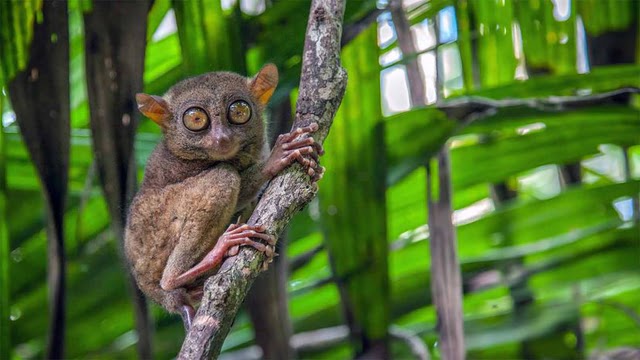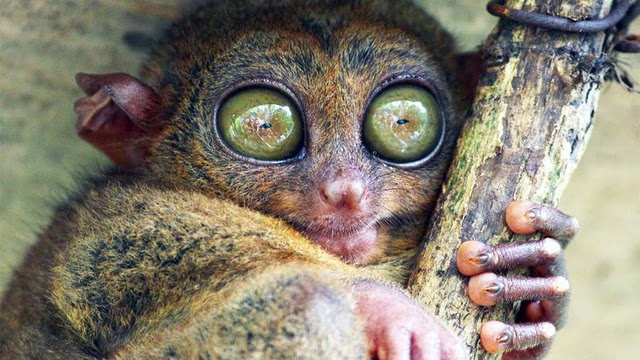Quck answer
The tarsier is a unique primate known for its enormous eyes, long fingers, and ability to turn its head almost 360 degrees. Despite its small size, it has the largest eye-to-body ratio of any mammal. Tarsiers are nocturnal and feed on insects, using their sharp teeth and strong jaws to catch prey. They are found in Southeast Asia and are endangered due to habitat loss and the pet trade. Humans are related to tarsiers through our common ancestor, which lived about 60 million years ago.

Tarsiers are one of the smallest primates on the planet and reside mainly in the forests of Southeast Asia. As distant cousins of humans, these primates have been given different names since their discovery in the late 18th century, including Gremlins and Baby Yoda. But what makes them stand out?
Tarsiers have unique characteristics that make them oddly comparable to some of Hollywood’s most notable characters. Perhaps it’s the fact that they can rotate their head 180 degrees, or their disproportionate eyeball-to-head ratio that has earned them nicknames like Blarp, the tragic-looking CGI alien-monkey from the 1998 movie “Lost In Space.”
Tarsiers: A Fascinating Example of Primate Evolution
According to Myron Shekelle, Ph.D., an instructor and research associate in the biology department at Western Washington University, tarsiers are more than their weird mashup of features. They are a fascinating example of primate evolution, and Shekelle has conducted decades of research contributing to our knowledge of tarsiers and primate evolution.
Although every species has different characteristics, tarsiers tend to range in size from 3.5 to 6 inches long, with tails that can be twice that length. They have hairless rat-like tails or tufts of fur along the length of the tail or at the end. Like owls, they can rotate their head 180 degrees and have long legs, allowing them to jump and leap like lemurs. Their fingers are also exceptionally long, with small sticky pads at the ends to cling to trees where they live and hunt for prey.
Tarsiers are the only entirely carnivorous primate species on the planet. They eat insects, lizards, and even snakes found in the Southeast Asian forests.

Big Eyes of the Tarsier
Tarsiers have the biggest eyes of any mammal relative to their body weight, even for nocturnal mammals. Their eyes are enormous compared to their body size, and they lack a reflective eye layer that most other nocturnal animals have.
According to Shekelle, when a flashlight is shone into a forest at night, many animals will have a strong eye shine, such as cats, dogs, lemurs, bushbabies, and lorises. However, tarsiers do not possess this reflective layer. The tarsier’s eye compensates for this lack by being larger than expected. This unique feature offers researchers an exciting insight into primate evolution. As primates became diurnal, they lost the need for a tapetum lucidum. Tarsiers, who may have spent some time as diurnal primates before becoming nocturnal, had already lost this layer.
Shekelle and his colleagues identified several new species of tarsiers on the Indonesian island of Sulawesi, which led to a debate about where tarsiers belong on the primate evolutionary tree. They have similar characteristics to apes and humans, such as their lack of a tapetum lucidum, causing scientists to classify them as Haplorhini, which includes monkeys and apes.
Tarsiers are elusive and difficult to study, especially without the reflective layer. They also do poorly in captivity, with their population decreasing quickly. Tarsier conservation is critical due to deforestation, mining, and their small size and limited population. The Sangihe tarsier, which is endemic to the island of Sangihe, is on the list of 25 most endangered primates in the world.
According to Shekelle, since there are more species of tarsiers than scientists studying them, it’s challenging to determine how endangered some of the species are across the various islands. Tarsius tumpara is a critically endangered species living on a tiny island called Siau Island. Shekelle wrote about this species in 2008. He hopes that with intentional conservation efforts, more tarsier species won’t become critically endangered. Shekelle suggests keeping tarsiers in their natural habitat in Indonesia, and protecting them with proper cages and expert care to help them thrive and breed. However, getting tarsiers into a well-controlled environment is a complex process that requires time, expertise, and financial investment. Interestingly, fossil evidence indicates that tarsiers are one of the oldest primates globally and have lived all over the world, including North America and Europe, for at least 55 million years.
FAQ
1. What is a tarsier?
A tarsier is a small primate that is native to Southeast Asia. They are known for their unique physical characteristics, including their large eyes, long legs, and elongated feet. Tarsiers are nocturnal and spend most of their time in trees, hunting for insects and small prey.
2. How are tarsiers related to humans?
Tarsiers are primates, just like humans. This means that we share a common ancestor, although it is estimated that our last common ancestor lived around 60 million years ago. However, tarsiers are more closely related to lemurs and lorises than to monkeys and apes.
3. Why are tarsiers considered weird?
Tarsiers are considered weird because of their unique physical characteristics. They have huge eyes that are each larger than their brain, and they can rotate their heads almost 180 degrees. They also have long legs and elongated feet with long toes, which they use to grasp onto branches and move through the trees.
4. Are tarsiers endangered?
Yes, many species of tarsiers are endangered due to habitat loss and fragmentation. Tarsiers are highly specialized and require specific types of forest habitats to survive. As these habitats are destroyed, tarsiers are left with fewer places to live and hunt for food.
5. Are tarsiers kept as pets?
Unfortunately, yes. Tarsiers are sometimes captured and sold as pets, despite the fact that they are wild animals that require specific habitats and diets to remain healthy. Keeping a tarsier as a pet is illegal in many countries, and can lead to the animal’s death or poor health.
6. Do tarsiers have any predators?
Yes, tarsiers have a number of predators in the wild, including snakes, birds of prey, and some species of carnivorous mammals. However, their biggest threat is habitat loss, which can lead to population declines and reduce their ability to survive and reproduce.
7. How do tarsiers communicate with each other?
Tarsiers communicate with each other through a variety of vocalizations, including chirps, whistles, and trills. They also use body language, such as ear movements and tail flicks, to communicate their intentions and emotions to other tarsiers.
8. Can tarsiers be found in zoos?
Yes, tarsiers can be found in some zoos and wildlife parks around the world. However, it is important to ensure that these animals are being kept in appropriate conditions and that their needs are being met. Many zoos participate in breeding programs to help conserve endangered tarsier species.





Leave a Reply